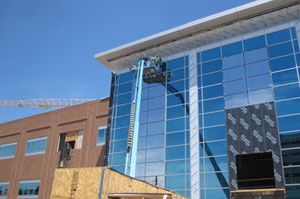Despite efforts to get health care spending under control, hospitals are still racing to build expensive new technology — even when the devices don’t necessarily work better than the cheaper kind. Case in point: proton beam therapy, a high-tech radiation treatment for cancer.
Washington, D.C., is on the verge of approving two proton treatment facilities at a total cost of $153 million. They would be built and owned by the two dominant hospital systems in the region: Johns Hopkins Medicine and MedStar Health. At the same time, the Maryland Proton Treatment Center is already under construction in Baltimore, 40 miles away.
Hopkins and MedStar have been pleading their cases before a local health department agency that grants hospitals the right to build new buildings and services. Both health systems argue that the nearest proton therapy centers are too far away for Washington residents to use.
“We believe that this therapy is absolutely necessary, but we also think that it’s appropriate to be applied to certain types of cancer with certain treatments and not everything,” says Chip Davis, president of Sibley Memorial Hospital in an upscale neighborhood of Washington, where the Hopkins proton center would be built. The center would open in 2017 and is projected to generate $15.8 million in profits in 2019.
MedStar’s facility would be part of MedStar Georgetown University Hospital, in another upscale neighborhood of Washington D.C. MedStar refused requests to be interviewed for this story.
The Sibley and MedStar Georgetown plans are controversial.
“Neither should be building,” says Dr. Ezekiel Emanuel, a former health care adviser to the Obama administration who is now at the University of Pennsylvania. “We don’t have evidence that there’s a need for them in terms of medical care. They’re simply done to generate profits.”
The higher costs of proton services ultimately trickle down to taxpayers, employers and consumers in the form of higher health insurance premiums.
“It’s hard to bend the cost curve when you’re spending a lot of money,” says Emanuel. “These are tens if not hundreds of thousands of dollars in treatment for interventions that do not improve survival, improve quality of life, decrease side effects, or save money.”
The 90-Ton Cyclotron
There are already 11 proton therapy centers in the U.S., and the Maryland Proton Treatment Center is one of 17 more being developed.
The Baltimore facility is a giant cement-encased building the size of a football field, with a price tag of more than $200 million, funded by for-profit developer Advanced Particle Therapy.
At its heart sits a 90-ton piece of equipment called a cyclotron, which accelerates protons until they’re whizzing around at two-thirds the speed of light. The stream of protons is then directed at a tumor site, delivering a high-dose blast of radiation. The hope is that the proton beam is so focused that only the tumor gets irradiated, causing fewer side effects.
The treatment center will be staffed by physicians from the University of Maryland. Radiation oncologist Dr. Minesh Mehta, who will direct the center, says he’s hopeful that the technology could be used to treat up to a quarter of all cancers.
“At the end of the day, when I tell the patient I can treat you with technology that will treat less of your normal tissue with radiation you don’t need vs. more radiation to tissue that should not be radiated, which would you like to choose?” Mehta says. “The vast majority of patients will choose the technology that gives less radiation to their tissues.”
Studies suggest that proton therapy is promising for children who have brain and spinal tumors, protecting the fragile developing organs near the cancer and preventing future developmental delays and secondary tumors. But childhood cancers are rare, and there’s not much clinical evidence that proton therapy is better than standard radiation for most other cancers.
The particular “spot scanning” proton technology used at the Maryland center has not undergone any randomized clinical trials at all, Mehta acknowledges.
A study published in the Journal of the National Cancer Institute in December found that prostate cancer patients who received proton therapy had no fewer side effects than those treated with standard radiation, despite it being “substantially more costly.”
Mehta says the center will treat about 200 patients a day, at a cost twice that of standard radiation. This includes patients with prostate, lung, abdominal and other cancers. Mehta estimates that 90 percent of the patients treated at the center will be adults, and up to 35 percent will be prostate cancer cases.
“It’s hard to find a lot of children with brain cancers you can treat with the device, but you can find millions of men with prostate cancer,” notes Amitabh Chandra, an economist and professor of public policy at the Harvard Kennedy School of Government. And because the centers usually cost $100-200 million to build, a high patient volume is the only way they can afford to stay in business, he says.
Mehta argues that studies that show disappointing results for prostate cancer are based on flawed data sets and do not reflect the true value of proton therapy.
Doctors at the University of Maryland say their proton center is more than enough for all of the patients in the Washington-Maryland region. They’ve even invited radiologists at both Hopkins and MedStar to practice there.
That’s unlikely to happen. A committee of Washington’s State Health Planning and Development Agency has recommended that both proposed centers be allowed to move forward. A final decision from the agency director is expected soon.
Reporter David Schultz contributed to this story.








